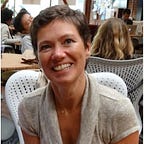Whole Systems Economic Development: A Regenerative Approach
Article 1, Part 5
By Beatrice Ungard and Ben Haggard (with the Regenerative Economy Collaborative)
States of Development
One way to avoid fragmentation when working on a community’s economic development is to assess progress not only in terms of material objectives but also in terms of changes in state. A community that is growing its capacity and capabilities will change from the inside, becoming more intelligent and able to work as an integrated system to accomplish complex and long-range goals. The different states that any given community will pass through are unique to it. However, there are a number of general patterns:
Investment Ready
To even begin a process like the one described, a community must have come to a state where its members are willing to acknowledge that “business as usual” will not help them to flourish. Recognizing that who they are as a community is something precious to care for and protect, they may also fear that conventional revitalization approaches will end up undermining their integrity as a place. Faced with this challenge, they will seek to invest in their own development to build the capacity and capability required for regenerative work.
Getting to this state might be particularly difficult when the community faces a crisis like the current Coronavirus epidemic with its harrowing consequences of death, business bankruptcy, unemployment, and more. Yet, while actions aiming to stabilize a critical situation are necessary, we believe it is especially in such times that a shift in thinking is required in order to rebuild society on stronger foundations. Indeed, one of the hallmarks of an institution or community that has invested in learning to think regeneratively is that it can pivot quickly, utilizing sudden changes or disruptions to work on systemic improvements.
Being Body
For a community to embrace its distinctive characteristics and unique potential as a source of economic potential, it must generate a living understanding of its place. From this, it becomes increasingly able to experience itself as a whole, a living entity, connected to and expressive of its landscapes, ecosystems, cultures, and story. This provides a community with a deeply rooted and authentic identity, one from which its future can be grown.
Self-Organizing Ways of Working
At this stage, a community has developed sufficient self-awareness and agency in its members that they can begin to lead the change process. Choices about which initiatives to pursue are driven by insights about how to express and evolve the inherent wealth of place rather than by individual self-interest or personal agenda. Getting people to set aside their own narrow interests in favor of contributing to collective development requires ongoing commitment to their own personal development. However, building collective will happens naturally when people rally around the same purpose.
Field Generation
Whether it is vital and uplifting or downtrodden and depressing, the quality of energy and spirit present in a community influences thinking and behavior, and therefore how people inhabit their place. Generating an energy field that inspires people to embrace and pursue change is critical to the long-term success of a regenerative process, as it supports their ownership of and commitment to this challenging but rewarding work. Because energy fields have a tendency to collapse or degrade over time, a community must learn to continuously regenerate the quality of energy needed to sustain cooperation and alignment among its members.
In Summary
In this article, we described a regenerative approach to community economic development. Our premise was that communities are often unconscious of the multiple forms of inherent wealth that are available to them. This wealth is carried by the spirit of their peoples, the richness of their cultures, the dynamism of their ecosystems, and all of these can be nurtured and amplified as a basis for securing a community’s viability and well-being. Even where financial capital is scarce and fixed capital is degraded, local ingenuity and strategic thinking can leverage undervalued local resources to generate abundance. But this depends on the development of local strategic thinking and leadership capabilities. In our experience, investment in these is the best way to avoid the negative impacts of traditional economic development strategies.
To help readers envision how a process like this might unfold, we presented a framework that has helped to guide and structure our work with a variety of community economic development initiatives in specific locations. It has provided a structure for us to assist communities as they experiment with ways to manifest a new kind of economy. In the following three articles we will describe on-the-ground projects where we have used this approach and explore the learnings and challenges we encountered.
Acknowledgements
We thank our reviewers from The Regenerative Economy Collaborative — Cindy Brooks, Sidney Cano, Ricardo Peon, Hector Miramontes, and Johan Clémançon, for the deeply insightful suggestions and comments they provided about this article.
